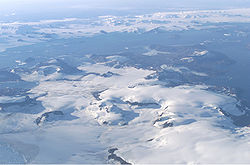James Ross Island
| James Ross | |
 James Ross Island from the air | |
|---|---|
| Location | |
| Location: | 57°45’0"S, 64°9’0"W |
| Area: | 1,003 square miles |
| Highest point: | Mount Haddington, 5,348 feet |
| Data | |
James Ross Island is a large island off the south-east side and near the north-eastern extremity of Graham Land, separated from Graham Land's Trinity Peninsula by the Prince Gustav Channel.
The island is irregularly shaped and extends forty miles in a north–south direction, and rises to 5,348 feet above sea level at the summit of its highest mountain, Mount Haddington.
The island was discovered by Sir James Clark Ross, the prodigious Arctic explorer, who commanded the British Antarctic expedition of 1839-43 which discovered and roughly charted a number of points along the eastern side of the island. However Ross did not identify this land as an island, as it is landfast to the mainland by ice. It was discovered to be an island and charted in October 1903 by the Swedish Antarctic Expedition under Otto Nordenskjöld, who named it for Ross. The style, James Ross Island is used to avoid confusion with the more widely known Ross Island in McMurdo Sound in New Zealand’s sector of the continent. It has appeared on some Spanish-language charts as Isla de Haddington (and variants), in association with Mount Haddington.
The island was connected to the Antarctic mainland by an ice shelf until 1995, when the ice shelf collapsed, making the Prince Gustav Channel passable for the first time.[1]
Mendel Polar Station, the first Czech Antarctic Base, is located on the island.
Paleontology
Two dinosaur-bearing formations are present on the island, both from the Upper Cretaceous: the Santa Marta Formation and the Snow Hill Island Formation. These are two of only three known formations to have dinosaur fossils in Antarctica.
The first dinosaur ever discovered in Antarctica was Antarctopelta oliveroi, a medium-sized ankylosaur found on James Ross Island by the Argentinian geologists Eduardo Olivero and Roberto Scasso in 1986. The dinosaur was recovered from the Campanian stage of the Upper Cretaceous Santa Marta Formation, about a mile south of Santa Marta Cove on the north part of the island. The ankylosaur was not formally named until 2006.[2]
In December 2003, the American paleontologist Judd Case from Saint Mary's College of California and geologist James Martin from the South Dakota School of Mines & Technology discovered the bones of a theropod dinosaur on the island. Nicknamed "Naze" after the northerly Naze peninsula on which it was found, the Late Cretaceous remains include an upper jaw and teeth, and most of the lower legs and feet. Little information is available, but the shape of the leg and feet indicate it was a runner, and the size indicates it was probably six feet tall and weighed 300 lb. This is the second Antarctic theropod discovered, after Cryolophosaurus.[3]
An ornithopod was found in the Snow Hill Island Formation by Argentine paleontologists Rodolfo Aníbal Coria and Juan José Moly in 2008. In 2013, Coria named it Trinisaura santamartaensis[4].
In 2015, an iguanodontid found in 2002 by Fernando Novas[5] was named Morrosaurus antarcticus by Sebastian Rozadilla, Federico Lisandro Agnolin, Fernando Emilio Novas, Alexis Rolando Aranciaga Mauro, Matthew J. Motta, Juan Manuel Lirio Marcelo and Pablo Isasi. The genus name refers to the site of El Morro on James Ross Island, where the remains of the species were found. The specific name refers to Antarctica.
See also
References
- ↑ Rubin, Jeff (2008). Antarctica, p. 276. Lonely Planet.
- ↑ Salgado, L.; Gasparini, Z. (2006). "Reappraisal of an ankylosaurian dinosaur from the Upper Cretaceous of James Ross Island (Antarctica)". Geodiversitas 28 (1): 119–135.
- ↑ "A Lost World: Two Previously Unknown Dinosaurs Discovered in Antarctica". Maryland VIP K-16 Grant (Science Inquiry). Archived from the original on 2007-09-29. https://web.archive.org/web/20070929014807/http://www.scienceinquiry.org/index.php?area_id=418. Retrieved 2007-04-04.
- ↑ Coria, R. A.; Moly, J. J.; Reguero, M.; Santillana, S.; Marenssi, S. (2013). "A new ornithopod (Dinosauria; Ornithischia) from Antarctica". Cretaceous Research. doi:10.1016/j.cretres.2012.12.004.
- ↑ Novas, F.E., A.V. Cambiaso, J. Lirio, & H. Núñez, 2002, "Paleobiogeografía de los dinosaurios cretácicos polares de Gondwana", Ameghiniana (Resúmenes) 39(4): 15R
- Gazetteer and Map of The British Antarctic Territory: James Ross Island